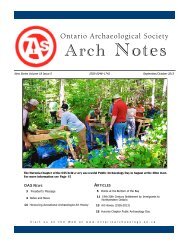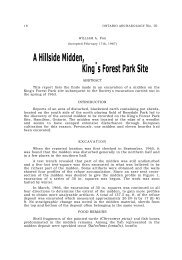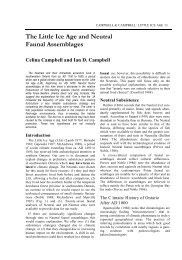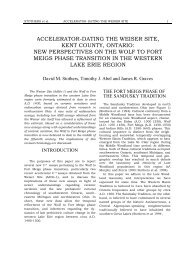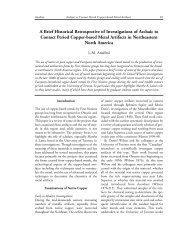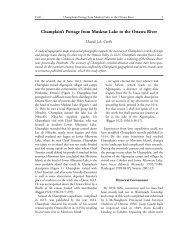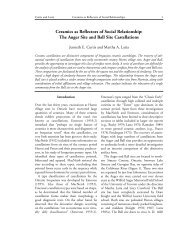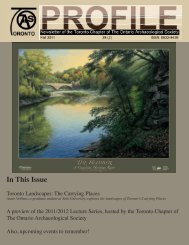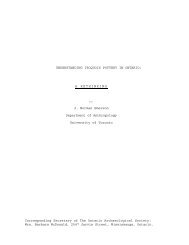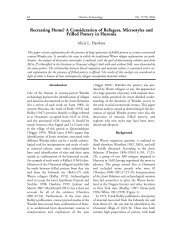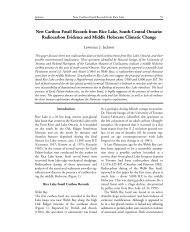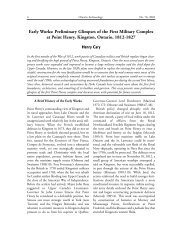Huron-St. Lawrence Iroquois Relations in the Terminal Prehistoric ...
Huron-St. Lawrence Iroquois Relations in the Terminal Prehistoric ...
Huron-St. Lawrence Iroquois Relations in the Terminal Prehistoric ...
You also want an ePaper? Increase the reach of your titles
YUMPU automatically turns print PDFs into web optimized ePapers that Google loves.
PENDERGAST: HURON-ST. LAWRENCE RELATIONS 35<strong>Lawrence</strong> <strong>Iroquois</strong> sites <strong>in</strong> Jefferson County and <strong>St</strong>.<strong>Lawrence</strong> <strong>Iroquois</strong> pottery which can he attributedto Jefferson County is present on late prehistoric<strong>Huron</strong> sites. On <strong>the</strong> basis of <strong>the</strong> concept describedabove, this suggests <strong>Huron</strong> men and women werepresent <strong>in</strong> late prehistoric <strong>St</strong>. <strong>Lawrence</strong> <strong>Iroquois</strong>villages <strong>in</strong> Jefferson County. And <strong>St</strong>. <strong>Lawrence</strong><strong>Iroquois</strong> men and women lived <strong>in</strong> late prehistoric<strong>Huron</strong> villages.This is quite unlike <strong>the</strong> situation which prevailedwith regard to <strong>the</strong> <strong>St</strong>. <strong>Lawrence</strong> <strong>Iroquois</strong> <strong>in</strong> easternOntario and sou<strong>the</strong>rn Quebec. Their men were notpresent <strong>in</strong> late prehistoric and protohistoric <strong>Huron</strong>villages.However, <strong>the</strong> condition which permitted <strong>St</strong>.<strong>Lawrence</strong> <strong>Iroquois</strong> males from Jefferson County tobe present <strong>in</strong> <strong>Huron</strong> villages and not those fromeastern Ontario and sou<strong>the</strong>rn Quebec should not betaken to <strong>in</strong>dicate amicable relations prevailedbetween <strong>the</strong> Jefferson County <strong>Iroquois</strong> and <strong>the</strong><strong>Huron</strong>. It seems more likely that <strong>the</strong> reciprocaldistribution of artifactual traits demonstrated hererepresent a phase <strong>in</strong> <strong>the</strong> conflict when both maleand female captives were acceptable on each side.Certa<strong>in</strong>ly <strong>the</strong> changes <strong>in</strong> <strong>the</strong> conduct of <strong>the</strong> war,which was fought <strong>in</strong>itially under prehistoric conditionswhen <strong>the</strong> <strong>St</strong>. <strong>Lawrence</strong> <strong>Iroquois</strong> <strong>in</strong> JeffersonCounty and eastern Ontario were destroyed and later,circa 1580, under historic conditions when <strong>the</strong> <strong>St</strong>.<strong>Lawrence</strong> <strong>Iroquois</strong> <strong>in</strong> sou<strong>the</strong>rn Quebec weredestroyed, strongly suggests <strong>the</strong>re were phases <strong>in</strong>this war when <strong>the</strong> rules differed.<strong>Huron</strong> WarInterest<strong>in</strong>g observations have been raised regard<strong>in</strong>g<strong>the</strong> movement of <strong>the</strong> <strong>Huron</strong> from <strong>the</strong> regionadjacent to Lake Ontario to <strong>the</strong> h<strong>in</strong>terland betweenLake Simcoe and Nottawasaga Bay. The hypo<strong>the</strong>siswhich attributes <strong>the</strong> destruction of <strong>the</strong> <strong>St</strong>. <strong>Lawrence</strong><strong>Iroquois</strong> to <strong>the</strong> <strong>Huron</strong> appears <strong>in</strong>consistent with <strong>the</strong><strong>Huron</strong> withdrawal from <strong>the</strong>ir traditional territoryalong <strong>the</strong> north shore of Lake Ontario, some ofwhich was adjacent to <strong>the</strong> <strong>St</strong>. <strong>Lawrence</strong> <strong>Iroquois</strong>.Withdrawal from traditionally held territory is amark of defeat and <strong>the</strong> <strong>Huron</strong>, <strong>the</strong> hypo<strong>the</strong>sisalleges, were <strong>the</strong> victors, not <strong>the</strong> losers.Archaeological evidence <strong>in</strong>dicates <strong>the</strong> late prehistoric<strong>Huron</strong> sites on <strong>the</strong> Trent River axis <strong>in</strong>Pr<strong>in</strong>ce Edward and Hast<strong>in</strong>gs counties, <strong>the</strong>Waupoos, Payne and Lite sites (Pendergast 1963,1964, 1972), were <strong>in</strong> contact with <strong>the</strong> <strong>St</strong>. <strong>Lawrence</strong><strong>Iroquois</strong>. But <strong>the</strong>re is no evidence of a sequence of<strong>Huron</strong> sites <strong>in</strong> this region which cont<strong>in</strong>ues throughto <strong>the</strong> protohistoric period. Protohistoric <strong>Huron</strong> siteson <strong>the</strong> Trent River axis, Benson and Trent(Emerson 1954; Ramsden 1977: Burger and Pratt1973 and personal communication), first occur wellnorth <strong>in</strong> Victoria County immediatelyeast of <strong>Huron</strong>ia. This suggests <strong>the</strong> <strong>Huron</strong> on <strong>the</strong>Trent River axis adjacent to <strong>St</strong>. <strong>Lawrence</strong> <strong>Iroquois</strong>territory did withdraw as a result of <strong>St</strong>. <strong>Lawrence</strong><strong>Iroquois</strong> pressure <strong>in</strong> <strong>the</strong> late prehistoric period. Thisis <strong>in</strong> sharp contrast to <strong>the</strong> <strong>Huron</strong> adjacent to LakeOntario west of <strong>the</strong> Trent River axis. The Drapersite (F<strong>in</strong>layson 1985) and o<strong>the</strong>rs <strong>in</strong> that clusterwhich were <strong>in</strong> contact with <strong>the</strong> <strong>St</strong>. <strong>Lawrence</strong> <strong>Iroquois</strong>rema<strong>in</strong>ed adjacent to Lake Ontario <strong>in</strong> <strong>the</strong> lateprehistoric period. O<strong>the</strong>r <strong>Huron</strong> also <strong>in</strong> contact with<strong>the</strong> <strong>St</strong>. <strong>Lawrence</strong> <strong>Iroquois</strong>, Parsons and BlackCreek (Emerson 1954; 1968), rema<strong>in</strong>ed on <strong>in</strong> <strong>the</strong>Toronto area well <strong>in</strong>to <strong>the</strong> late prehistoric period.It is noteworthy that <strong>the</strong> <strong>Huron</strong> <strong>in</strong> <strong>the</strong> region westof <strong>the</strong> Trent River axis rema<strong>in</strong>ed <strong>in</strong> <strong>the</strong> region afterthose on <strong>the</strong> Trent River axis adjacent to LakeOntario, closer to <strong>the</strong> <strong>St</strong>. <strong>Lawrence</strong> <strong>Iroquois</strong> territory<strong>in</strong> eastern Ontario and Jefferson County, hadmoved northward <strong>in</strong>to Victoria County immediatelyeast of <strong>Huron</strong>ia. Presumably <strong>St</strong>. <strong>Lawrence</strong> <strong>Iroquois</strong>pressure on <strong>the</strong>se <strong>Huron</strong>s was greater than itwas on <strong>the</strong> more remote <strong>Huron</strong> to <strong>the</strong> west of <strong>the</strong>Trent River. The eastern <strong>Huron</strong> were forced tomove northward <strong>in</strong> late prehistoric times while <strong>the</strong><strong>Huron</strong> west of <strong>the</strong> Trent rema<strong>in</strong>ed adjacent to LakeOntario. This <strong>in</strong>terpretation of currentarchaeological data would deny <strong>the</strong> premise that<strong>the</strong>re was a monolithic one-time movement of <strong>the</strong><strong>Huron</strong> from <strong>the</strong> region adjacent to Lake Ontarionorthward to <strong>Huron</strong>ia.ConclusionThe above <strong>in</strong>terpretation does not deny <strong>the</strong>hypo<strong>the</strong>sis that <strong>the</strong> <strong>Huron</strong> destroyed <strong>the</strong> <strong>St</strong>.<strong>Lawrence</strong> <strong>Iroquois</strong>. Ra<strong>the</strong>r it suggests that <strong>the</strong><strong>Huron</strong> adjacent to <strong>St</strong>. <strong>Lawrence</strong> <strong>Iroquois</strong> wereforced to react to <strong>St</strong>. <strong>Lawrence</strong> <strong>Iroquois</strong> pressures,as reflected by <strong>the</strong>ir move northward to VictoriaCounty, before <strong>the</strong> <strong>St</strong>. <strong>Lawrence</strong> <strong>Iroquois</strong> weredefeated. A corollary of this <strong>in</strong>terpretation suggeststhat <strong>the</strong> <strong>Huron</strong> west of <strong>the</strong> Trent River axis werenot forced to move northward by Five Nation <strong>Iroquois</strong>until after <strong>the</strong> late prehistoric Parsons andBlack Creek sites were occupied. That is, after <strong>the</strong><strong>St</strong>. <strong>Lawrence</strong> <strong>Iroquois</strong> had ceased to exist, apartfrom <strong>the</strong> remnants who rema<strong>in</strong>ed until circa 1580on <strong>the</strong> <strong>St</strong>. <strong>Lawrence</strong> River east of Hochelaga where<strong>the</strong>y met Cartier and <strong>the</strong> Frenchmen who followedhim <strong>in</strong> <strong>the</strong> 16th century. Then <strong>the</strong>y too succumbedto many pressures <strong>in</strong>clud<strong>in</strong>g <strong>the</strong> Five Nation <strong>Iroquois</strong>,<strong>the</strong> <strong>Huron</strong>, and European disease.At present <strong>the</strong> hypo<strong>the</strong>sis which suggests thathostilities with <strong>the</strong> <strong>Huron</strong> were, <strong>in</strong> part, responsiblefor <strong>the</strong> elim<strong>in</strong>ation of <strong>the</strong> <strong>St</strong>. <strong>Lawrence</strong> <strong>Iroquois</strong> <strong>in</strong>eastern Ontario, and later on <strong>the</strong> <strong>St</strong>. <strong>Lawrence</strong>River <strong>in</strong> sou<strong>the</strong>rn Quebec circa 1580, has beennei<strong>the</strong>r refuted nor improved upon. The



